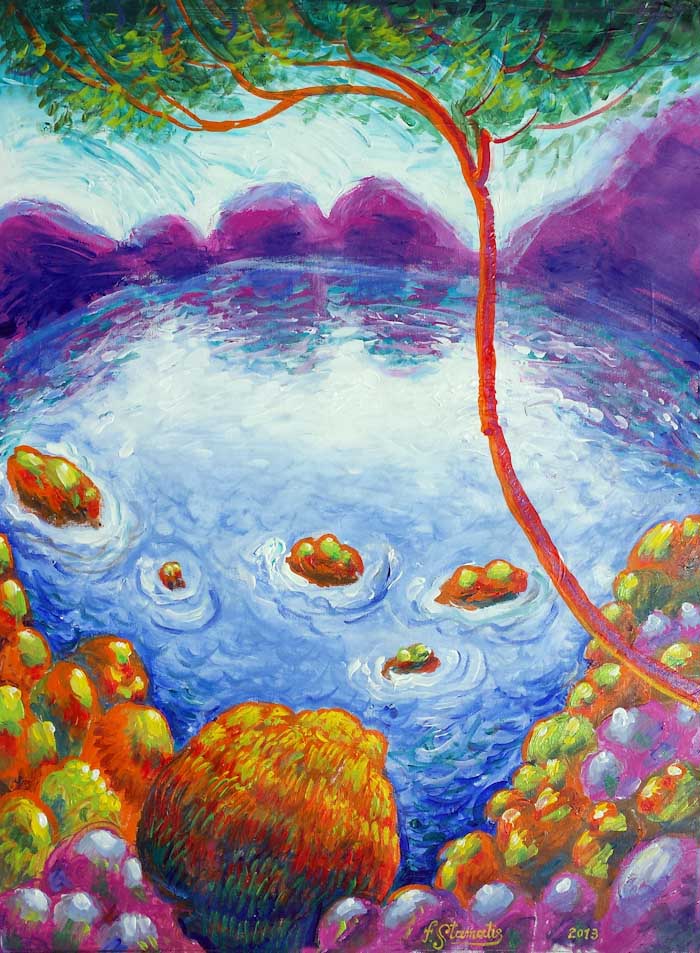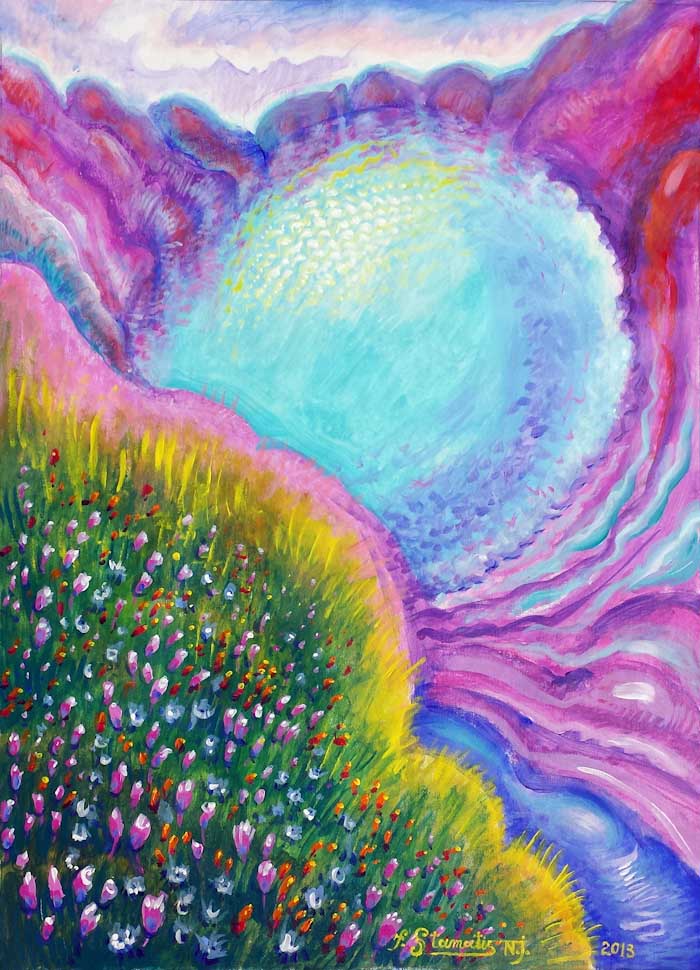Inspired by the painting of the National Parks of America
We walk on the very crust of the earth. Beneath us, a seething hot sun is hidden in a damp fiery form. Landscape painting is the portrayal of this crust, since the painter’s main concern is the rendering of three-dimensional space on a two-dimensional canvas. This burning sun wears its lava as a dried up skin that swallows up the flames.

Here we have a lighting condition known as “contre lumiere.” The viewer is set against the light, the distant hills are in shade, and the center of the lake acts as a mirror reflecting the sunlight. This glow gives a strong sense of the fluid and liquid character of the water.
The painter knows that beneath the landscape there is lava. He sees not only the surface, but also the depth. He also sees the crust as it once was, and wonders how it developed to this point. Looking at the landscape, he sees thousands of eruptions of lava. He sees the effects of precipitation, conflicts, subsidence, erosion, and partitions. All sorts of deformations of the Earth’s surface that led to its current form. The painter also predicts future variations of the landscape, because the same forces that acted and led to the present will create the future landscape. If the painter sticks to just one form, he will be unable to understand successive forms: he will be unable to understand the logic of the landscape’s anatomy, the sculptured form of the landscape. This is not surrealism or a dream, it is simply the changing nature of beings, the created-ness of their being. It is the familiarity of the painter with the forms of matter, which help him understand the changing nature of forms. This provides a panoramic sense and view of the entire development of the planet in the past and in the future. That grain of sand was once a solid monolith, and that monolith over there that our eye can see now will change, will dissolve, and will one day become a grain of sand, then quicksand, and then a vanishing powder.
The eye of the painter sees every surface of the landscape as perforated, fragile, and flimsy in the face of the changes produced by the actions of humanity. He sees the sandwiching of the natural landscape between man-made landscapes, which are expanding quickly, and that suffocate natural landscapes. He cannot, therefore, look at the landscape he is painting without noticing the effects of man’s insatiable and revolutionary attitude toward nature, and of nature’s peaceful obedience to the laws of nature. Somewhere within all these landscapes, even in the most primal and deserted corners, man exists. The creator and destroyer of landscapes, man is also the artist that creates works of art from primal nature. The crafty destroyer and creator doesn’t always appear in the landscape. Usually, he is behind the mountains, in the societies that shape the changing landscape and its fragile form.
But even the artist does not appear at first sight, because he paints, first from this perspective, and then from that perspective and, finally, he hides within his own work. He doesn’t let the landscape have its space. He places his own unique stamp upon it. Through his creativity, he makes the landscape his own. There is the classic scene that you’ve seen, and about which you say, “this is how Van Gogh painted the cypress tree.” That, over there, is St. Victoria Mount, not as seen in nature, but as painted by Cezanne, which is completely his own. The same is true for Kandinsky’s Blue Mountain, with its blue/mauve strokes. Wherever we take the work, wherever we put it, its painter comes along with it, because he can be found within it, and from within it he speaks to us across the ages, using his unique brush strokes as words that he hurls at us. These small, weak brushstrokes, however, appear to change the destiny of the landscape.

The rendering of the water’s natural shine is not the focus of this painting. Even though the lake’s surface is wrinkled with wavelets, the shapes and colors of the various elements are used to form a rhythm of colors and shapes.
Yes, the painting of a landscape is an act of destruction, similar to the breaking through of lava, which “paints” a completely new landscape. It is completely enigmatic, the birth of a passionate and infinite scene that does battle with the destiny of the planet and of man. Here is man, a landscape within the landscape, who is fragile like the rocks and spins together on his mother, the earth.
This man, with his paints, uses his senses to enter into the structure and depths of the earth and its destiny. The flame within him inspires him to liberate and to unify the discontinuities and conflicts of the landscape. He wants the rocks to be able to fly. He always wants all things to exist for all time, and to remember them all for all time. This is why he “immortalizes” them in his art.
There are also some other unique people who view the landscape in a different way, who are able to see what hides behind the hill, or behind the wall. They are able to enter into and to experience rocks and water from within, through their senses. They are able to see light in the middle of darkness. Let us call them “The Only True Landscape Painters.”
Stamatis Skliris

Leave a Comment
You must be <a href="https://poetics.holyicon.org/wp-login.php?redirect_to=https%3A%2F%2Fpoetics.holyicon.org%2Fon-the-changing-nature-of-forms%2F">logged in</a> to post a comment.